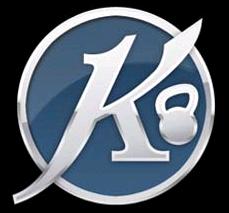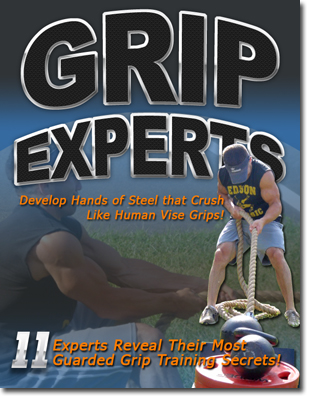Global Grip Challenge will be August 30th, 2008
Events will be Grippers, Two Hands Pinch, Axle Double Overhand Deadlift, Loading Medley and 6" Reverse Bending.
Get Your Entry Form Here
This is the Official United States Championship contest, and athletes must qualify in order to participate. Qualification must take place in US Hand Strength sanctioned contests that are announced on the the GripBoard. Qualifying lifts are listed below.
Events at a Glance
Grippers
MM, Credit Card, and TNS sets will be allowed. More points will be awarded for a wider set. Captains of Crush grippers will be used.
Two Hands Pinch
Normal rules apply. 4 attempts. Rising Bar. Pre-announced weights will be used.
Loading Medley
20 items to be loaded of all shapes and sizes.
Axle Deadlift
Full Lockout. 3 attempts. Rising Bar. Pre-announced weights will be used.
Reverse Bending
6" lengths Reverse style. 3 attempts. 30 second time limit bent to 40 degrees
Qualifications
Qualification Chance 1: Athletes shall qualify for Nationals if they finish top 3 in a US Hand Strength sanctioned contest announced on the Gripboard between September 2007 and August 2008.
Qualification Chance 2: Athletes can also qualify for Nationals by completing 3 of the following feats during 2007-2008 competition:1" Vertical Bar - 290
2" FBBC Vertical Bar - 200
Gripper - IM #3 or equivalent (140#), or 150# choker close
Reverse Bending - Grade 5x6" bolt
Axle Deadlift - 290
Plate Pinch - 170
Qualification Chance 3: Complete any one of the following Wild Card feats:Close #4 Gripper with parallel set or wider (choker included)
Break US Record in Two Hands Pinch
Break US Record in 1-inch Vertical Bar (LGC Standard or FBBC Standard)
EVENTS FOR NATIONALS ARE SUBJECT TO CHANGE. Please continue to check back often for updates.
Feel free to leave comments here if you have any questions.
-NAPALM-
Thursday, May 29, 2008
GGC Event Rules and Entry Form
Wednesday, May 28, 2008
Ultimate Warrior Returns to the Ring
One my favorite wrestlers as a kid, and one of the most controversial wrestling personalities these days will return to the ring in Barcelona, Spain in July - the Ultimate Warrior. I am not sure how much fanfare that match will bring, but that all aside, it is inspiring to see that with hard work and dedication, you can stay in excellent shape well into your 40's, as evidenced by the Warrior's training video, here.
Read more at the Pro Wrestling Pundit.
-NAPALM-
Sunday, May 25, 2008
Athletic Performance from a Different Angle
This is an interview that Smitty recently did with John Alvino! John is a strength and conditioning specialist and an advisor for Men's Fitness. John gets amazing results with the athletes he trains. He is well known in the industry for getting his athletes completely ripped, and stronger than ever. I asked John to tell me a little bit about his fat loss protocol for athletes. Here's what he had to say:
Tell me, why is it important for athletes to maintain a lean physique and how can they do it without affecting their performance?
Most athletes want to become leaner to improve their sports performance. Unfortunately, most of the fat loss methods out there actually act as an enemy to athleticism. A typical fat loss program involves eating low calories, which significantly hampers the athlete's ability to recover. Athletes tend to experience a decrease in performance as well as a lack of energy when they employ these fat loss protocols for too long.
For your body to function optimally, you must take in an adequate amount of nutrients in order to aid in recovery, prevent injury, and keep your immune system healthy. Fat loss training methods tend to completely ignore this fact about the human body. Thus, most fat loss programs end up making you weaker, slower, and less explosive. Moreover, typical fat loss methods actually encourage the fast twitch muscle fibers to take on characteristics of slower twitch fibers (for those of you who don't know, it is your fast twitch fibers that provide you with explosive strength and quickness). These are very serious consequences to a high level athlete. Fortunately, there is a better way.
My fat loss approach actually encourages more athleticism, more power, and more explosiveness, as well as a higher level of anabolic hormones (testosterone and growth hormone). My athletes find that as they get leaner, their conditioning for their sport actually improves, as does their energy levels. They feel lighter on their feet, yet stronger and even more explosive than they were before. That's because my program is specifically designed to burn fat while encouraging dexterity, speed, and a maximum maintenance of lean muscle.
I usually have only 12 weeks to train an athlete prior to their returning to camp for pre-season. Although their primary goal is to get stronger and faster, I also like to get them as lean as possible. In the 12 weeks they work with me, it is quite typical that my athletes lose 20 lbs of body fat, and yet they make great gains in their strength, power and conditioning. My athletes excel in the strength and conditioning tests upon returning to camp: exercises such as vertical jump, 40 yard dash, 225-lb for reps on the bench press, power cleans, squats, etc.
Here are a few keys to successful fat loss for an athlete:
Do not lose more 2 lbs per week.
Doing so can result in water loss, lean muscle loss, and rapid glycogen depletion. This is turn causes weakness, loss of endurance, fatigue, reduced mental focus, and increases the athlete's susceptibility to injury.
Don't cut carbs too low.
Carbohydrates are an athlete's primary source of energy. It is essential not to restrict carbohydrates too much for too long. This will directly decrease power output and performance in general.
Emphasize cardiovascular activities that engage fast twitch fibers.
By doing so, you ensure that you will not lose power or lean muscle mass as a result of your cardio training. Also, by training this way, you will actually be better prepared for the rigorous requirements of the training regimen of your particular sport, as well as the demands of the sport itself.
Avoid working out exclusively in the high rep range.
High reps are a common prescription in any fat loss program. The athlete's perception is usually that a high rep workout is a better and more thorough workout. They sweat more and the workout often feels more taxing; thus, they mistakenly feel that this means they are burning more fat. There is a big price to pay for this misconception.
The truth is that the high rep protocol is yet another reason performance can decrease. The weight that is used is just too light to adequately engage the neuromuscular system. This, in conjunction with the high volume of these workouts, this protocol often contributes to muscle wasting, and causes the athlete to become slower and weaker
------
John Alvino is not the typical "bodybuilding" trainer. All of his fat loss techniques have been refined and perfected on the top level athletes he has trained for the last 7 years.
Check out his program here - Click Here















